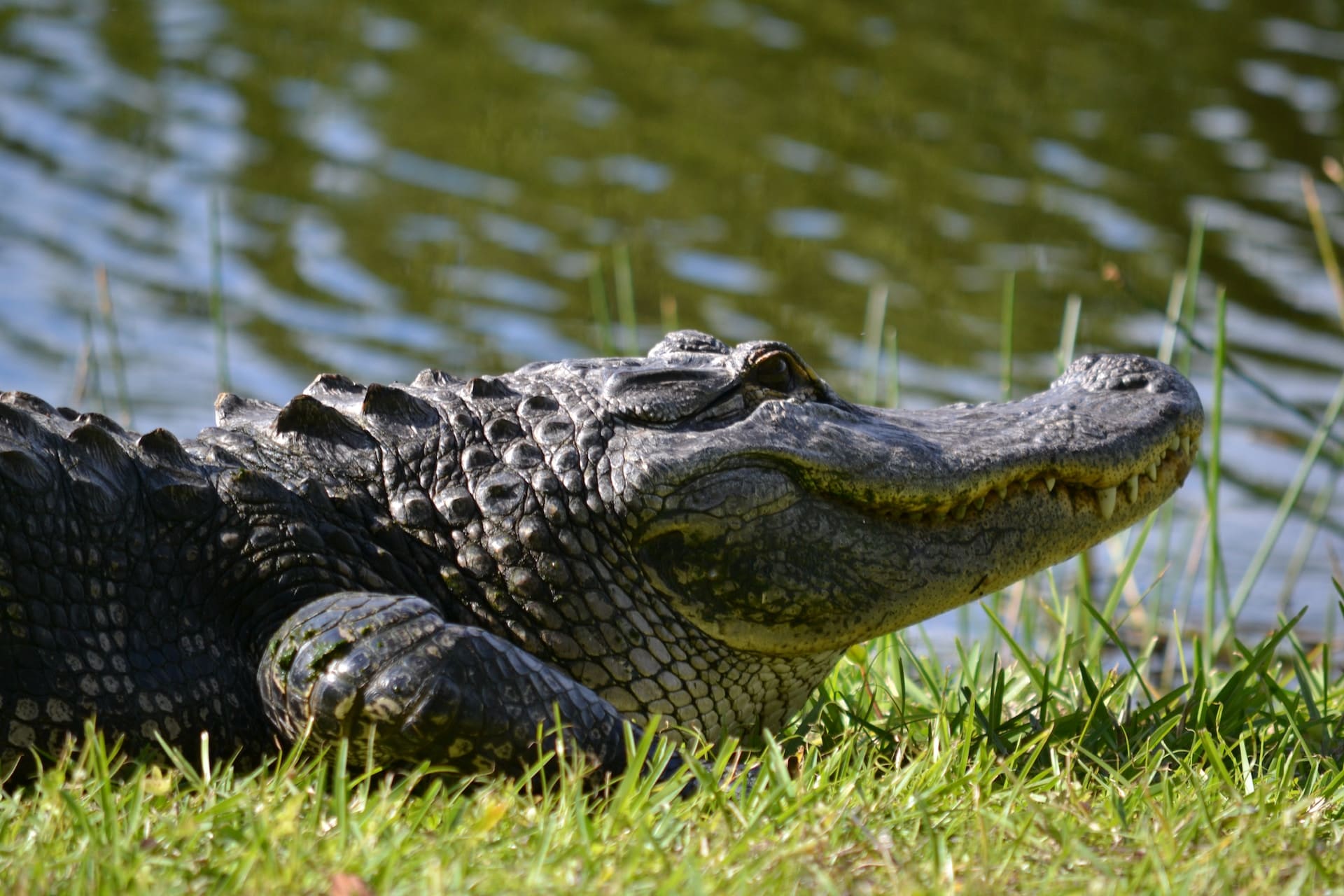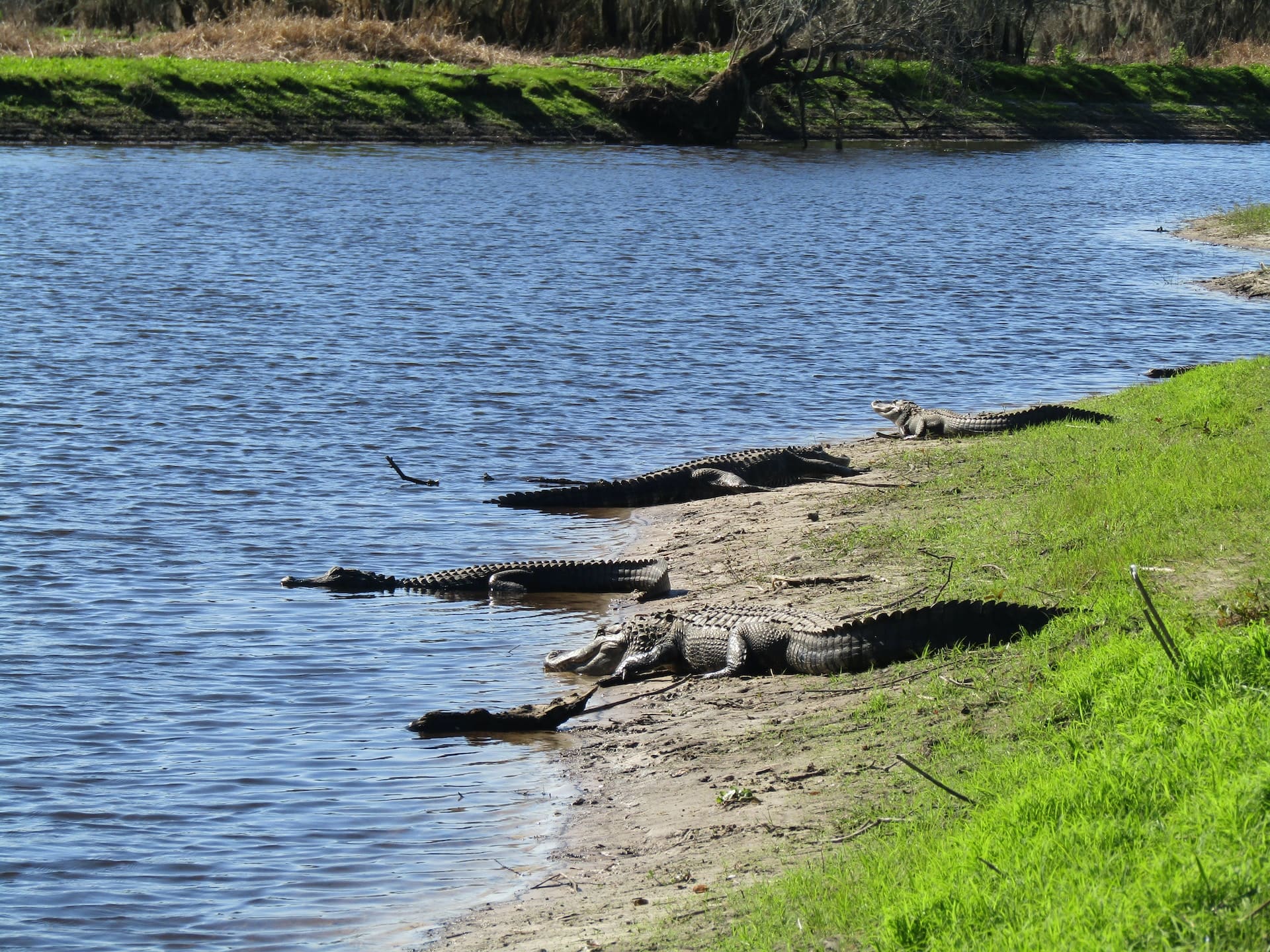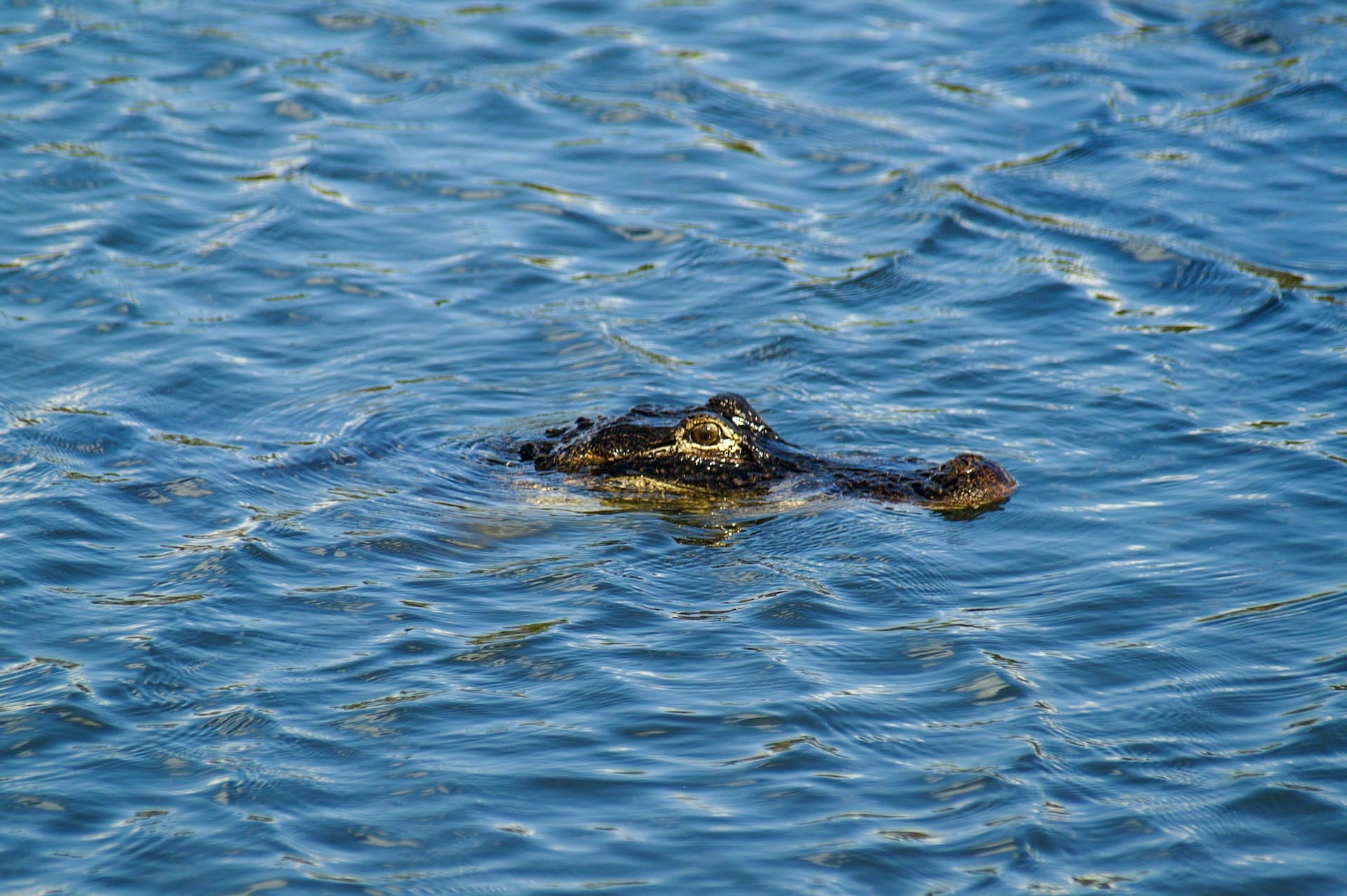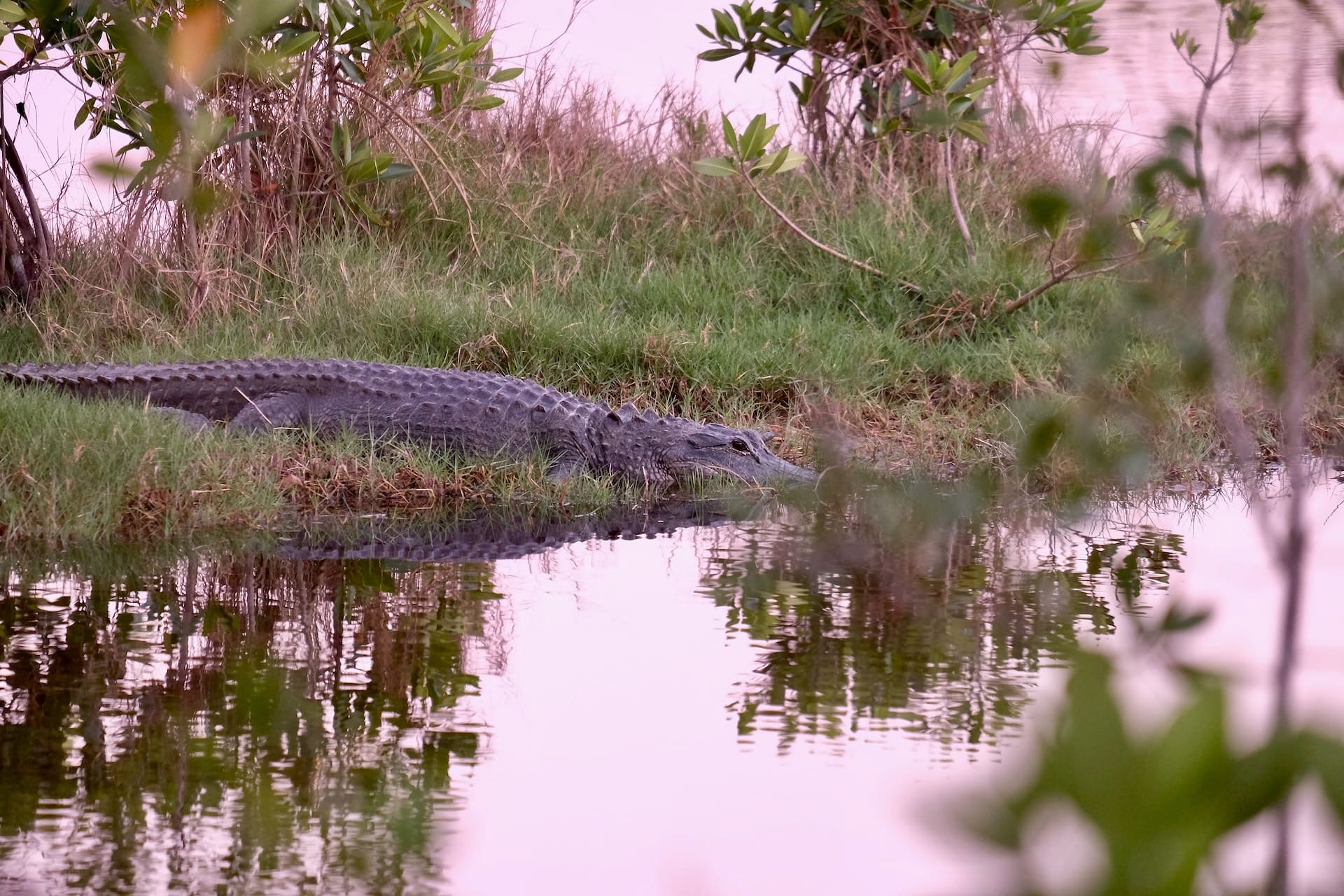Travelers visiting Okeechobee are often drawn to see and experience Lake Okeechobee alligators as well as the area’s history and rural culture.
The vast freshwater lake isn’t just known for being one of the most scenic recreational oases in the state, it’s also home to to Florida’s relatively famous reptile inhabitants.
We’re going to take a journey through the lakes and marshy areas to answer the question: “Does Lake Okeechobee have alligators?”

While alligators may be one of the more notable and defining features of the Florida ecosystem, they are also a figurehead of nature’s wonder, the curiosity of survival, and of course, raw power.
On our deep dive into the world of Lake Okeechobee alligators, we’ll uncover not only the pure adrenaline of the adventure ahead but also the rich history behind these majestic, if not slightly terrifying creatures.
We’ll learn about their overall role in the ecosystem and why they’re so vital, and we’ll learn more about their place in the general culture of Florida.
In the end, we’ll have gotten an understanding of how they’re much more than just dangerous wildlife and a symbol of the entire region’s heritage.
There’s a lot to cover, so let’s fire up the airboat and head into the heart of Florida to learn more about the alligators in Lake Okeechobee.
The Alligators in Lake Okeechobee
If you were to ask almost anyone what kind of wildlife they think of when they think of Florida, the most popular answer would undoubtedly be alligator.
Sure, you’ll get an answer here or there for mosquitos, maybe the conch or other locally beloved seafood specialties, but at its core, the beating heart of Florida is covered in scales.
Alligators are so prevalent in the state that the Florida University team is named for them, and the freshwater center of Florida, Lake Okeechobee, is no exception.

Lake Okeechobee is teeming with alligators, the American Alligator to be specific, which is a species revered as much as it is feared.
If you’re still asking “Are there alligators in Lake Okeechobee?” the answer is undoubtedly, unequivocally, yes.
The Alligator is a Symbol of Florida
The American Alligator is a symbol of wild, untamed Florida wilderness, and it thrives in the marshy waters of Lake Okeechobee as well as much of the rest of the state’s swampy interior.
The lake creates the perfect habitat for these massive reptiles, holding ample food and enough nesting sites to support thriving population replenishment.
The Lake Okeechobee alligator population is a testament to the rich biodiversity of the local ecosystem, and visitors to the lake typically find themselves intrigued by their majesty as well as their mystery.
Alligators are seen as a valuable local resource, and their presence at locations like Lake Okeechobee is another element of raw natural beauty to be appreciated at the lake and surrounding areas.
The Alligator as a Necessary Predator
The Lake Okeechobee alligators aren’t just a local symbol of culture or tourism, they’re a critical capstone in the local ecology of the lake and the state at large.

The American alligators of Lake Okeechobee help maintain a crucial balance and local apex predators, they help control the population of various bird species, as well as help maintain the levels of various components of aquatic life, which helps keep a larger balance in the local ecosystem.
Visitors that have the chance to observe these alligators in their natural habitat can offer a glimpse into the intricate symphony of nature, and the specific role that each member plays in it.
Historical Significance of Alligators in the Region
The alligators of Lake Okeechobee aren’t just a local ecological marvel and blessing, but they also bear a rich historical legacy that stretches back to long before Florida became a bustling coastal hub for adventurers and tourists.
For centuries beyond count, the alligators of Lake Okeechobee played a significant, even central role, in the lives and lore of many of the indigenous cultures, and as a result, the lives and lore of the early colonizers and other settlers of the area.
Native American tribes held a deep reverence for the alligator and viewed them as powerful spiritual symptoms, integrating them into the myths and legends of their cultures.

Alligators were seen as symbols of strength, survival, guardians of the waterways, and as such, vital parts of the natural world.
As more settlers from Europe arrived and penetrated deeper into the Florida wilderness, they often encountered alligators for the first time, which led to a unique mix of fear, respect, and ultimately, fascination.
Many early records from explorers and settlers are peppered with references to alligators, not only giving insight into how they were perceived but also into how commonly they were seen and how prevalent they were, overall.
The Lake Okeechobee alligators weren’t just a source of wonder for locals, they also played practical roles in these communities, helping contribute to their sustenance and overall survival.
Exploring Alligator Habitats in Lake Okeechobee
Now that you’ve digested a little bit of basic information about the local alligators at Lake Okeechobee, you might be feeling the call of adventure from an area absolutely packed with natural beauty.
Okeechobee County has everything that adventure enthusiasts as well as wildlife lovers would appreciate, and allows full immersion into unique, even once-in-a-lifetime activities.
Visitors have the chance to witness these prehistoric creatures in their natural environment by checking out one of the area’s many guided tours of the Lake Okeechobee alligators in their natural environment.
These expert-led tours lead visitors through the marshes and winding waterways, giving them an exhilarating yet still safe glimpse of these intense reptiles.

These tours are among the most popular things to do on the Treasure Coast and will often include substantial educational components that teach the participants about the alligators’ typical diet, behavior, and their role in the ecosystem.
These tours are available in several different varieties, depending on the thrill-seeking desire of the visitor, and include boat, kayak, and foot tours.
Safety Around Alligators
Even though some of the most memorable, key attractions at Lake Okeechobee will center around some aspect of alligators, safety is still one of the primary concerns with any tour or alligator-focused activity.
Even as awe-inspiring as these creatures are, they are very much still wild animals, and are in no way able to be domesticated, making it critical to respect their space.
Here are some things to remember during any Lake Okeechobee activity where alligators may be involved:
- Always Keep A Safe Distance: Keep a considerable distance from any alligator, because even though they seem slow and lethargic, they can move incredibly fast when near prey.
- Never Feed Alligators: This goes without saying, but feeding alligators is unbelievably dangerous and it is typically illegal as well since it makes them associate humans with food.
- Don’t Go Swimming In Alligator Habitats: Another obvious one, or so you’d think, but don’t go swimming or wading in waters where alligators are known to be.
- Watch Pets & Kids: Small animals and children can attract the attention of an alligator due to their size, so keep them both close at all times when in an area known for alligator activity.
- Stay Away From Nests: Remember that you’re a visitor in their home, and if you spot a nest, be sure to steer clear since they are not typically left unguarded.
- Follow All Park Rules & Guidelines: Be sure you read and adhere to all posted signage and any other guidelines or directions given to you by park authorities since both are designed to protect you from wildlife and wildlife from you.
How Many Alligators Are in Lake Okeechobee?
One of the most common questions on Lake Okeechobee tours and from those visiting the area, is “How many alligators are in Lake Okeechobee?”
Getting a clear understanding of the population levels of these magnificent apex predators requires some estimation, but it can help provide some solid insight into the general health and overall balance of the lake’s ecosystem.
Estimating alligator numbers, however, is a difficult task in the best of times due to the animal’s elusive nature and the sheer vastness of the Lake Okeechobee area.
Wildlife management organizations though, as well as some scientific studies, do offer general estimates, with some being as high as 30,000, and others as low as about 9,000.
Several research and monitoring programs suggest Lake Okeechobee could be the single most alligator-populous lake in the entire state.
Conservation efforts and mindful wildlife management have all played substantial roles in this balance, with the animals’ natural survivability, and show that the population can be made sustainable while also protecting the biodiversity of the location.
Wrapping Up
That’s going to wrap up our look at the Lake Okeechobee alligators, and we hope that it’s left you with a much deeper appreciation of a creature that many people feel is just a simple savage.
The presence of the alligators in Lake Okeechobee is a sign of Florida’s rich ecological offerings, so remember to always respect and protect their space and habitat.










